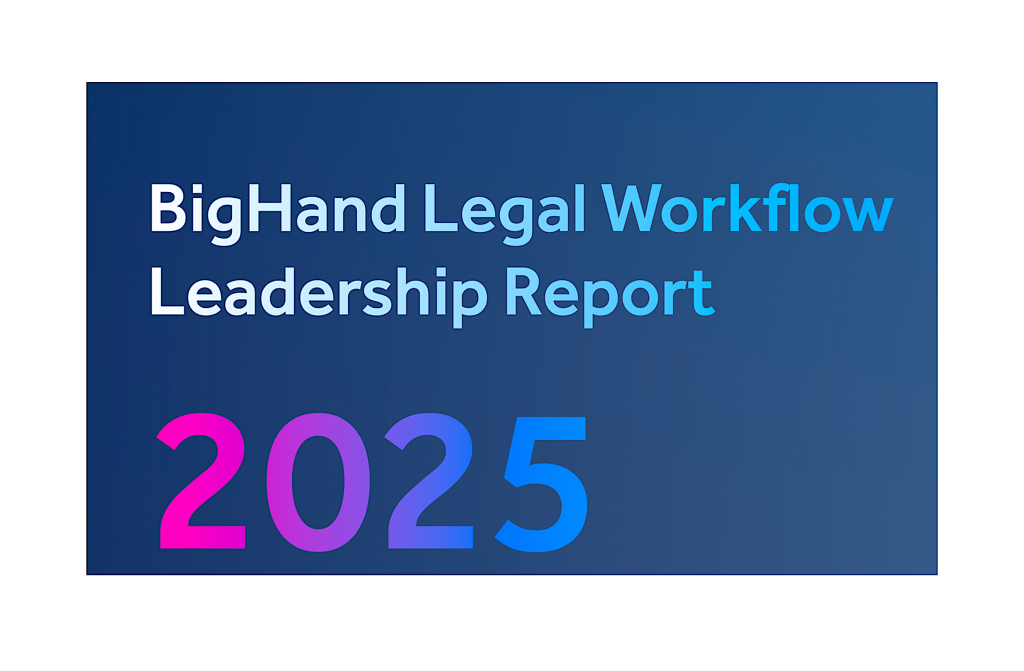
By Ben Jennings, BigHand.
Change in the legal industry comes very slowly. With so much at stake, most leaders are committed to trusted legacy workflows and SOPs. Why not? They’ve treated them well for years. Don’t mess with a good thing.
But while the industry is admittedly hesitant, it is not ignorant of the benefits that innovative tools and technologies offer. More and more, leadership is leaning into new opportunities and embracing a digital transformation (spurred on by a new generation of clients that demands transparency and efficiency).
We’re seeing cloud migration, AI experimentation, and a reimagining of administrative and support roles. Nine of every 10 respondents to BigHand’s Legal Workflow Leadership Report say they have restructured their support staff in the last 12 months. More than half (56%) expect further changes this year.
There’s just one problem. These decisions are being made without the right data. Even worse, they’re sometimes being made with no data at all.
The same report found that just 36% of firms are tracking productivity through dedicated task management technology. That leaves nearly two-thirds using manual methods, simple task completion rates, or subjective quality of work measures.
If the legal industry is going to shift away from direct support roles to a more centralised administrative structure – and it is, there’s no doubt about that – it needs to embrace more holistic workflow tech. Not just operate on hunches and emotion.
There’s No One On Your Desk
The traditional relationship between lawyers and their support staff is one that deserves envy. For decades, assistants, secretaries, and administrators have directly supported lawyers, allowing them to do, well, more lawyering.
Partners and associates could rely on their administrative assistants to have insider knowledge of specific matters, clients, and processes. But that relationship is changing, for better or for worse. Support staff churn is sky-high, and more than two-thirds (69%) of legal leaders rate the difficulty of replacing these roles at five or more out of ten.
How are firms dealing with it? For many, it’s through centralization.
Most (90%) have transitioned to some form of team-based support. There is a clear trend away from the traditional one-to-one relationship and towards fully centralized structures. In 2023, just 1% of firms had a structure with no direct lawyer support. Today, that number has climbed to 16%.
The value of this restructuring presents immediately. More than two-thirds (70%) of those that have implemented support teams cite multiple benefits, including things like:
Improved lawyer productivity
Increased cost savings
Better output quality
Plus, clients continue to demand more workflow transparency. They want to see their money spent effectively. A centralized team with proper data prioritization protects firms against the pain and reputational damage of lost work because of inefficiencies. Prove your team is as efficient as possible, and you’ll see client retention increase as a result.
Administrative Burden and Delegation Issues
Who assumes the responsibilities of a retiring support role if you can’t replace them? Sure, you can just funnel these tasks into a new centralized team, hoping they will get picked up by the remaining staff. But that leads to a new problem: How do we know the work is being done?
Lawyers are like electricity. They look for the path of least resistance. Often when their direct support is removed, they’ll default to one of two things:
Delegate through email, with no visibility over task acceptance, progress, and status
Do the work themselves
That second one is a killer. Nearly one-third of firms are now experiencing an increased reliance on lawyers to handle administrative tasks. It reduces their potential billable hours, slashes into their profitability, and, frankly, wastes their time. With such high bill out rates (even for junior associates), admin work is a serious profit leech.
Enter the Workflow Manager
So, what’s the answer here? Is centralization good or bad?
It’s not that simple.
Moving towards a team-based administrative approach is necessary (especially so for mid-tier firms, which are experiencing even more workload falling on their lawyers). But it must be done with the right data, the right management, and the right processes.
Surprisingly, the industry seems to be having trouble getting it right. Despite the strong trend towards centralization, the number of firms with dedicated workflow managers has declined in recent years (55% in 2023 to just 48% in 2025). Just 11% plan to recruit them in the next 24 months.
While every firm is different, that could prove a mistake for many. By empowering a talented manager with the right workflow tech, you can gain full visibility into your productivity, resource levels, aptitude, and capacity. That means no longer working in the dark. No more hunches. No more blind spots. Significant opportunity.
Final Thoughts
No one is advocating for an immediate overhaul of all legal support staff. They are a critical part of the work that goes on inside a firm. But change is coming one way or another, and those that operate without the right visibility are going to be left behind. Slow is okay; smart is better.
The resulting ROI speaks for itself. Quality increases, efficiency increases, profit increases.
If you want to explore more insights from over 800 legal leaders, download the full report. It includes five years of data, showing just how persistent (and in several cases pressing) these issues are.
About the author: Ben Jennings is BigHand’s Global Director – Workflow Management.
–
[ This is a sponsored thought leadership article for Artificial Lawyer by BigHand. ]
Discover more from Artificial Lawyer
Subscribe to get the latest posts sent to your email.

